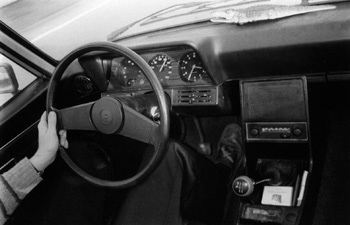
Broad Runners
Ant Farm, Robert Barry, Michel de Broin, Chris Burden, Hans-Peter Feldmann, Peter Gnass, Rodney Graham, Abbas Kiarostami, Margaret Lawther, John Massey, Simon Morris, N.E. Thing Co., Edward Ruscha, Jon Sasaki, Roman Signer, Stephen Shore, Kerry Tribe, Bill Vazan, Jeff Wall, Ian Wallace
Curated by Marie-Josée Jean, director of VOX, contemporary image center, Montreal.
VOX, contemporary image center
March 11 - April 26, 2009
1211 Saint-Laurent Boulevard
Montreal (Quebec)
Canada H2X 2S6
Cinémathèque québécoise
March 11 - April 26, 2009
335, De Maisonneuve East Boulevard
Montreal (Quebec)
Canada H2X 1K1
VOX, contemporary image center, in collaboration with the Cinémathèque québécoise is pleased to announce Road Runners, an exhibition which brings together works and documents from the 1920s to the present day which focus on experiences of the road.
The road and the automobile are subjects and objects of major literary, cinematic and artistic works that laid the foundations of a cross-disciplinary genre––one which continues to evolve. The crystallization of that genre, here designated by the term "Road Runners," came during the 1950s and 1960s with the publishing of Jack Kerouac's novel On the Road, Tony Smith's account of his aesthetic experience on a highway, and the release of Dennis Hopper's Easy Rider. Though the Road Runner may be characterized by diverse attitudes and motivations, the road and the automobile have generated new modes of representation and perception, in one or another of these forms.
But while in film and literature the road runner's motivation is often an identity quest that sets him or her in motion, in response to a need for escape, a desire for vision and revelation, the artist's wanderings are rather of mental nature––conceptual, even. In the early 1950s, Tony Smith arrived at a staggering redefinition of art when he went for a night ride along the unfinished New Jersey Turnpike, without signs or lighting. He had an "unstructured" experience of the landscape, which he could not frame or transform into an art work because it remained forever immaterial. These narratives ushered in a new relationship to art in which the art object was deconstructed, giving way to a new paradigm wherein the conceptual dimension and the experienced event were most important.
Beginning in the late 1960s, that paradigm engendered countless works whose structure was informed by the road, with the car functioning as a moving studio––with the driver watching the world roll by, continuously, on the screens that are its windows. The framing of those road-images is often doubled by the tighter frame of the car windows, and onto the observed landscape are superimposed reflected views in the windshield and rear-view mirrors. This way of seeing the world, widespread in North America, and especially in Canada, was to exert a huge influence on several Conceptual artists, who used photography to record it. The very act of seeing, previously perceived as something transparent, became the subject of their art.
The history of photography is also replete with road runners, who along the way have produced a register of ongoing urban and social transformations in North America. Photographers are especially attracted to the non-spaces characteristic of American landscapes, focusing their attention on transitional spaces (motels, restaurants, gas stations) and arteries of communication (roads, crossroads, highways, boulevards). In the 1980s, image production on the road became animated, and storytelling began to predominate. Film and video became more prevalent, and artists employed the narrative structures characteristic of these media. Several artists took to the road in this way, offering (with either critical or humorous aims) unexpected experiences.
The exhibition will be complemented by a program of films entitled Sur les routes, put together especially for the occasion by the Cinémathèque québécoise.
The book Bill Vazan: Walking into the Vanishing Point. Œuvres conceptuelles – Conceptual Art is also launched at this occasion.